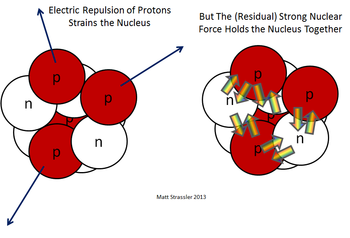Neutron: Difference between revisions
J.williams (talk | contribs) m (1 revision imported) |
No edit summary |
||
| Line 1: | Line 1: | ||
[[category:Phets]] | |||
[[Category:Done 2018-06-15]] | |||
[[File:Nuclear force.png|350px|thumbnail|Figure 1. The electrical force pushing protons apart and the strong force acting on both protons and neutrons inside a nucleus<ref>Prof. Matt Strassler [Online]. Available: http://profmattstrassler.com/articles-and-posts/particle-physics-basics/the-structure-of-matter/the-nuclei-of-atoms-at-the-heart-of-matter/what-holds-nuclei-together/ [Accessed on 24 October 2014]. </ref>]] | [[File:Nuclear force.png|350px|thumbnail|Figure 1. The electrical force pushing protons apart and the strong force acting on both protons and neutrons inside a nucleus<ref>Prof. Matt Strassler [Online]. Available: http://profmattstrassler.com/articles-and-posts/particle-physics-basics/the-structure-of-matter/the-nuclei-of-atoms-at-the-heart-of-matter/what-holds-nuclei-together/ [Accessed on 24 October 2014]. </ref>]] | ||
<onlyinclude>'''Neutrons''' are neutrally [[charge]]d particles that are found in the [[nucleus]] of [[atom]]s, along with the positively charged [[proton]]s.</onlyinclude> As you can see in figure 1, the protons are pushed apart by the [[electromagnetic force]], but pulled together by the [[strong force]], which is stronger at short distances (these distances are about a [[meter|fm]] or 10<sup>-15</sup> m). The strong [[force]] comes from the interactions among the protons and neutrons. Neutrons are incredibly small, about 10<sup>-15</sup> [[meter|m]], 10,000x smaller than an atom! Please see [[size of the universe]] for some online demonstrations to show this scale. | <onlyinclude>'''Neutrons''' are neutrally [[charge]]d particles that are found in the [[nucleus]] of [[atom]]s, along with the positively charged [[proton]]s.</onlyinclude> As you can see in figure 1, the protons are pushed apart by the [[electromagnetic force]], but pulled together by the [[strong force]], which is stronger at short distances (these distances are about a [[meter|fm]] or 10<sup>-15</sup> m). The strong [[force]] comes from the interactions among the protons and neutrons.<ref>Hyperphysics "Fundamental Force", Hyperphysics, 2018. [Online]. Available: http://hyperphysics.phy-astr.gsu.edu/hbase/Forces/funfor.html#c2. [Accessed: 19- Jun- 2018]</ref> Neutrons are incredibly small, about 10<sup>-15</sup> [[meter|m]], 10,000x smaller than an atom! Please see [[size of the universe]] for some online demonstrations to show this scale. | ||
The number of neutrons in a nucleus determines what [[isotope]] the nucleus is. Some isotopes are stable, and some aren't, depending on the ratio of protons to neutrons. If a nucleus has too many neutrons, it undergoes one type of [[beta decay]] and if has too few neutrons, it undergoes the opposite type of [[beta decay]], see the bottom of the page for a PhET simulation about this stability. These decays are due to another force called the [[weak force]]. | The number of neutrons in a nucleus determines what [[isotope]] the nucleus is. Some isotopes are stable, and some aren't, depending on the ratio of protons to neutrons. If a nucleus has too many neutrons, it undergoes one type of [[beta decay]] and if has too few neutrons, it undergoes the opposite type of [[beta decay]], see the bottom of the page for a PhET simulation about this stability. These decays are due to another force called the [[weak force]]. | ||
| Line 15: | Line 16: | ||
<html><iframe src="http://phet.colorado.edu/sims/html/build-an-atom/latest/build-an-atom_en.html" width="816" height="459"></iframe></html> | <html><iframe src="http://phet.colorado.edu/sims/html/build-an-atom/latest/build-an-atom_en.html" width="816" height="459"></iframe></html> | ||
==For Further Reading== | |||
To learn about the other forces, please see the following pages: | |||
*[[Proton]] | |||
*[[Weak nuclear force]] | |||
*[[Strong force]] | |||
*[[Fundamental force]] | |||
*Or explore a [[Special:Random|random page]] | |||
==References== | ==References== | ||
{{reflist}} | {{reflist}} | ||
[[Category:Uploaded]] | [[Category:Uploaded]] | ||
Revision as of 19:13, 19 June 2018

Neutrons are neutrally charged particles that are found in the nucleus of atoms, along with the positively charged protons. As you can see in figure 1, the protons are pushed apart by the electromagnetic force, but pulled together by the strong force, which is stronger at short distances (these distances are about a fm or 10-15 m). The strong force comes from the interactions among the protons and neutrons.[2] Neutrons are incredibly small, about 10-15 m, 10,000x smaller than an atom! Please see size of the universe for some online demonstrations to show this scale.
The number of neutrons in a nucleus determines what isotope the nucleus is. Some isotopes are stable, and some aren't, depending on the ratio of protons to neutrons. If a nucleus has too many neutrons, it undergoes one type of beta decay and if has too few neutrons, it undergoes the opposite type of beta decay, see the bottom of the page for a PhET simulation about this stability. These decays are due to another force called the weak force.
Neutrons are made of smaller particles called [1] (or see hyperphysics), which also make up protons.
To learn more about neutrons please see hyperphysics.
Phet: Build an Atom
The University of Colorado has graciously allowed us to use the following Phet simulation. This simulation builds atoms from protons, neutrons and electrons and tests knowledge of the periodic table. The simulation shows how the neutrons and protons must balance for the nucleus to be stable.
For Further Reading
To learn about the other forces, please see the following pages:
- Proton
- Weak nuclear force
- Strong force
- Fundamental force
- Or explore a random page
References
- ↑ Prof. Matt Strassler [Online]. Available: http://profmattstrassler.com/articles-and-posts/particle-physics-basics/the-structure-of-matter/the-nuclei-of-atoms-at-the-heart-of-matter/what-holds-nuclei-together/ [Accessed on 24 October 2014].
- ↑ Hyperphysics "Fundamental Force", Hyperphysics, 2018. [Online]. Available: http://hyperphysics.phy-astr.gsu.edu/hbase/Forces/funfor.html#c2. [Accessed: 19- Jun- 2018]

